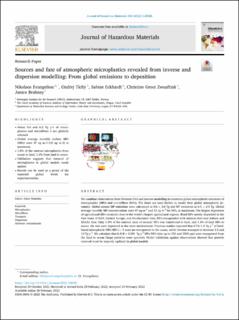| dc.contributor.author | Evangeliou, Nikolaos | |
| dc.contributor.author | Tichý, Ondřej | |
| dc.contributor.author | Eckhardt, Sabine | |
| dc.contributor.author | Zwaaftink, Christine Groot | |
| dc.contributor.author | Brahney, Janice | |
| dc.date.accessioned | 2022-03-21T10:51:29Z | |
| dc.date.available | 2022-03-21T10:51:29Z | |
| dc.date.created | 2022-03-18T10:30:53Z | |
| dc.date.issued | 2022 | |
| dc.identifier.citation | Journal of Hazardous Materials. 2022, 432, 128585. | en_US |
| dc.identifier.issn | 0304-3894 | |
| dc.identifier.uri | https://hdl.handle.net/11250/2986408 | |
| dc.description.abstract | We combine observations from Western USA and inverse modelling to constrain global atmospheric emissions of microplastics (MPs) and microfibers (MFs). The latter are used further to model their global atmospheric dynamics. Global annual MP emissions were calculated as 9.6 ± 3.6 Tg and MF emissions as 6.5 ± 2.9 Tg. Global average monthly MP concentrations were 47 ng m-3 and 33 ng m-3 for MFs, at maximum. The largest deposition of agricultural MPs occurred close to the world’s largest agricultural regions. Road MPs mostly deposited in the East Coast of USA, Central Europe, and Southeastern Asia; MPs resuspended with mineral dust near Sahara and Middle East. Only 1.8% of the emitted mass of oceanic MPs was transferred to land, and 1.4% of land MPs to ocean; the rest were deposited in the same environment. Previous studies reported that 0.74–1.9 Tg y-1 of land-based atmospheric MPs/MFs (< 5 mm) are transported to the ocean, while riverine transport is between 3.3 and 14 Tg y-1. We calculate that 0.418 ± 0.201 Tg y-1 MPs/MFs (size up to 250 and 2500 µm) were transported from the land to ocean (large particles were ignored). Model validation against observations showed that particle removal must be urgently updated in global models. | en_US |
| dc.language.iso | eng | en_US |
| dc.rights | Navngivelse 4.0 Internasjonal | * |
| dc.rights.uri | http://creativecommons.org/licenses/by/4.0/deed.no | * |
| dc.title | Sources and fate of atmospheric microplastics revealed from inverse and dispersion modelling: From global emissions to deposition | en_US |
| dc.type | Peer reviewed | en_US |
| dc.type | Journal article | en_US |
| dc.description.version | publishedVersion | en_US |
| dc.rights.holder | © 2022 The Author(s). Published by Elsevier B.V. | en_US |
| dc.source.volume | 432 | en_US |
| dc.source.journal | Journal of Hazardous Materials | en_US |
| dc.identifier.doi | 10.1016/j.jhazmat.2022.128585 | |
| dc.identifier.cristin | 2010764 | |
| dc.relation.project | Norges forskningsråd: 275407 | en_US |
| dc.relation.project | NILU - Norsk institutt for luftforskning: 118063 | en_US |
| dc.source.articlenumber | 128585 | en_US |
| cristin.ispublished | true | |
| cristin.fulltext | original | |
| cristin.qualitycode | 2 | |

